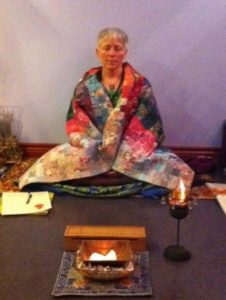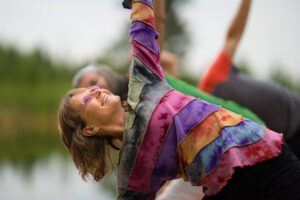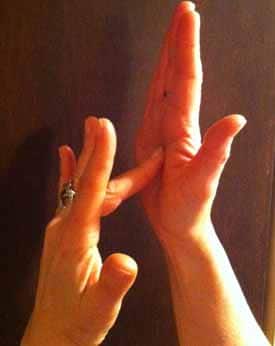Original article by Helen Mikuska, SOYA Alumni, E-RYT500, IYTA
 Yoga sadhana means “spiritual practice.” The word “sadhana” in Sanskrit can be translated as “ an effort consistently exercised towards the achievement of a purpose.” In this sense, every effort we put forth is some kind of sadhana, because it leads to the achievement of some intended goal. Yoga sadhana is the yoga practices that we do each day to lead us closer to our goal of healing and uniting body, mind and spirit. As we move closer to this goal through our effort, the more we experience our True spiritual state, one of wholeness, joyfulness and peace.
Yoga sadhana means “spiritual practice.” The word “sadhana” in Sanskrit can be translated as “ an effort consistently exercised towards the achievement of a purpose.” In this sense, every effort we put forth is some kind of sadhana, because it leads to the achievement of some intended goal. Yoga sadhana is the yoga practices that we do each day to lead us closer to our goal of healing and uniting body, mind and spirit. As we move closer to this goal through our effort, the more we experience our True spiritual state, one of wholeness, joyfulness and peace.
Why should I practice yoga sadhana?
The value of a daily physical and spiritual yoga practice helps to keep us grounded. For the majority of us, we find it difficult to maintain a daily yoga practice with the demands of work and family schedules. Practicing yoga sadhana is the means to let go of the ego, personal agendas and attachments and is a discipline undertaken in the pursuit of a goal. It is a tool to help work on yourself, to re-discover the purpose of your life, to help open doors, and to let you live your life as you desire. This requires us to develop the yama of tapas, one the personal characteristics we are encouraged to develop . Tapas is our own ability to act in our lives.
What are the benefits of practicing yoga sadhana?
- Commitment – You are putting yourself first and allowing yourself to grow further in your yoga practice.
- Discipline – By practicing yoga regularly, it will help to build discipline, quieting down the mind and the ego, and will bring us inner peace.
- Evolution – If you find yourself stagnating, this is your opportunity to commit to a daily practice as a means to make sure that every single day is just a little bit better than the last one, no matter what else is going on in your life.
- Foundation – Yoga Sadhana is like planting a tiny little seed in the garden. Every day you practice you water it and it
Study Hatha Yoga Practices with SOYA 200 Hour Foundational Yoga Teacher Trainings, Retreats and Self Directed Yoga Studies.
How to choose a personal yoga sadhana practice?
The first aspect of Yoga Sadhana is to choose what is in your practice and the second aspect relates to regularity – doing something at consistent periodic intervals. This disciplined practice allows one to learn from it and enables one to make it a regular life habit, maximizing the benefits. There are many Hatha Yoga practices that we can learn and develop mastery over.
Kriyas, Pranayamas, Asanas, Mantras, Meditations, Mudras and Yoga Nidra. Each of these are like tool boxes, full of many practices we can choose from. Finding the tools that are right for us is part of the journey.

Practices like jala neti, jiva sodhana, and japa meditation are commonly part of daily yoga sadhana.
Kriyas – Are known as Shatkarmas which are the cleansing practices of the physical body. Shatkarmas not only have a positive effect on our well-being but they also purify our mind helping us to develop an inner awareness. Both body and the mind become lighter. Shatkarmas aim at mental, moral and spiritual elevation.
Pranayamas – Breathing practices are also essential for cleansing and purifying the physical and astral body. They help to maintain the flow of blood (toning the nerves, brain, spinal cord and cardiac muscles) and protect the internal organs and cells. They free us from energetic blockages. They strengthen and free the mind, sharpen the intellect and illuminate the Self.
Try this 5 minuted guided audio of Dirgha Pranayama.
 Asanas – The principle of movement can be seen in all the activities of the body (nervous system, muscles, joints, circulation, digestion, etc.) and with movement there is life. Where there is no movement or activity there is decay and death. We are somewhere in between these two states.
Asanas – The principle of movement can be seen in all the activities of the body (nervous system, muscles, joints, circulation, digestion, etc.) and with movement there is life. Where there is no movement or activity there is decay and death. We are somewhere in between these two states.
Mantras – The practice of Japa is a method of spiritual communion through the repetition of the Sanskrit mantra and practiced with the use of a mala. By continued repetition you create certain vibrations in your system. The recitation of the mantra fills the mind with spiritual vitality. An easy mantra to start with is So Ham, which means I am one with the Creator and all of creation.
Meditation – Meditation trains us in concentration. The practice of going inside is of fundamental importance in the process of evolving the aspects of personality through yoga. When we develop the ability to relax our mind at will, it gives us a sense of mastery over the vagaries of the mind and allows us to maintain it in a positive state.
Mudras – Mudras are “closed energy circuits” and can be created with the hands, the body, and even with the gaze. In hand mudras, we form these circuits by connecting fingers in various ways. Every part of the hand is linked to a specific part of the brain. Bending, crossing, expanding and touching the fingers or particular portions of the hand, stimulating reflex zones and meridians has a direct effect on the body and mind.
Learn about Mudras with SOYA Self Led Philosophy Studies
Try this hand mudra:
A Mudra for Living Bravely with Full Expression of Self, Accomplishment & Success.
This mudra will help you maintain your core identity under stress. It stimulates your inner resources, giving you a sense of expansiveness & confidence to live from your destiny & inner truth instead of your fear.
In Sukhasana (easy crossed-leg sitting), with both elbows relaxed at sides of body, raise your right hand up to level of your face. Hold fingers straight together & pointed straight up with thumb relaxed & palm facing left. Bring the left hand up with the palm facing the body & fingers pointed to the right. Hold fingers together with thumb pointing up. The tip of middle finger of the left hand touches your right palm. Hold this mudra so that you first look right over the index finger, then slowly raise it & look into centre of the left palm. No special breath. Let your heart chant the mantra you love the most. Concentrate on your palm. Carefully gaze at palm & meditate on the lines on your palm. Your vision will start enlarging. Hold 11 minutes
Yoga Nidra – Yoga Nidra literally means “yoga sleep”. This a unique practice which facilitates a deep state of relaxation, enabling us to slow our mental waves significantly. It refers to the state that one has between wakefulness and being sound asleep, but it experienced with full awareness. It is the opportunity to deeply rest our mind, as it turns away from the outward moving senses, allowing us tap deeply into our spiritual centre.
Anyone can begin their own personal yoga sadhana, anytime. The effort must always come from within us, tapas, and it gets easier once we get started! Finding a teacher or guide that you trust, to help guide you in your yoga sadhana, is important too. Yoga has always been shared from teacher to student. It is how the science of yoga and yoga sadhana has been nurtured over the ages – embracing the efforts in personal practice, experiencing transformation that is evident to all and, inevitably, in teaching others how to do the same for themselves.
Learn more about the South Okanagan Yoga Academy


Recent Comments